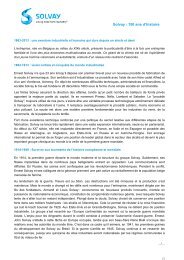Financial Statements - Solvay
Financial Statements - Solvay
Financial Statements - Solvay
Create successful ePaper yourself
Turn your PDF publications into a flip-book with our unique Google optimized e-Paper software.
138<br />
<strong>Solvay</strong> Global Annual Report 2008<br />
obtained on request by shareholders,<br />
in particular under the signature of the<br />
Chairman of the Board.<br />
3.6. Documentation<br />
Documentation relating to<br />
Shareholders’ Meetings (notice<br />
of meeting, agenda, proxy and<br />
notifi cation of participation forms,<br />
special report of the Board of<br />
Directors, etc.) is available every<br />
year on the Internet site<br />
www.solvay-investors.com. This<br />
documentation is available in French<br />
and Dutch (offi cial versions) and in<br />
English (unoffi cial translation).<br />
4. Board of Directors<br />
4.1. Role and mission<br />
The Board of Directors is the highest<br />
management body of the company.<br />
The law accords to it all powers<br />
which are not attributed, by law or<br />
by the by-laws, to the Shareholders'<br />
Meeting.<br />
In the case of <strong>Solvay</strong> SA, the Board<br />
of Directors has reserved certain key<br />
areas for itself and has delegated<br />
the remainder of its powers to<br />
an Executive Committee (see<br />
below). It has not opted to set up a<br />
Management Committee (Comité de<br />
Direction/ Directiecomité) as defi ned<br />
by Belgian law.<br />
The main key areas which the Board<br />
of Directors has reserved for itself are:<br />
1. Matters for which it has exclusive<br />
responsibility, either by law or under<br />
the by-laws, for example:<br />
the preparation and approval of<br />
the consolidated periodical fi nancial<br />
statements and those of <strong>Solvay</strong> SA<br />
(quarterly - consolidated only, halfyearly<br />
and annual) and the related<br />
communications;<br />
adoption of accounting standards<br />
(in this case the IFRS standards<br />
for the consolidated accounts and<br />
Belgian standards for the <strong>Solvay</strong> SA<br />
unconsolidated accounts);<br />
convening Shareholders’<br />
Meetings and drawing up the<br />
agenda and proposals for<br />
resolutions to be submitted to them<br />
(concerning, for example, company<br />
fi nancial statements, dividends,<br />
amendments to the by-laws, etc.).<br />
2. Setting the main policies and<br />
general strategic directions of the<br />
Group.<br />
3. Adopting the budget and longterm<br />
plan, including investments, R&D<br />
and fi nancial objectives.<br />
4. Appointing the Chairman and<br />
members of the Executive<br />
Committee and the Corporate<br />
Secretary, and setting their<br />
missions and the extent of the<br />
delegation of powers to the<br />
Executive Committee.<br />
5. Supervision of the Executive<br />
Committee and ratifi cation of its<br />
decisions, where required by law.<br />
6. Appointing from among its<br />
members a Chairman and a<br />
Vice-Chairman, and creating from<br />
among its members an Audit<br />
Committee, a Compensation and<br />
Appointments Committee and<br />
a Finance Committee, defi ning<br />
each Committee’s mission and<br />
determining its composition and its<br />
duration.<br />
7. Major decisions concerning<br />
acquisitions, divestitures, the<br />
creation of joint ventures and<br />
investments.<br />
Major decisions are considered to<br />
be those involving amounts of<br />
EUR 50 million or more.<br />
8. Setting the compensation of<br />
the Chairman of the Executive<br />
Committee, of Executive<br />
Committee members and of<br />
General Managers belonging to the<br />
Offi ce of the Executive Committee.<br />
9. Establishing internal Corporate<br />
Governance and Compliance rules.<br />
In all matters for which it has exclusive<br />
responsibility, the Board of Directors<br />
works in close cooperation with<br />
the Executive Committee, which in<br />
particular is responsible for preparing<br />
most of the proposals for decisions by<br />
the Board of Directors.<br />
4.2. Modus operandi and<br />
representation<br />
4.2.1. Board Members have available<br />
to them the information needed to<br />
carry out their functions in the form of<br />
dossiers drawn up under instructions<br />
from the Chairman and sent out to<br />
them by the Corporate Secretary<br />
several days before each session.<br />
They may also receive additional<br />
information of any kind that may be of<br />
use to them from, depending on the<br />
nature of the question, the Chairman<br />
of the Board, the Chairman of the<br />
Executive Committee or the Corporate<br />
Secretary.<br />
Decisions to obtain outside expertise,<br />
when necessary, are taken by the<br />
Board of Directors, for those subjects<br />
falling within its authority.<br />
4.2.2. The company is validly<br />
represented with regard to third<br />
parties by the joint signature of<br />
persons with the following capacities:<br />
the Chairman of the Board of<br />
Directors and/or directors belonging<br />
to the Executive Committee.<br />
For documents relating to the dayto-day<br />
management of the company,<br />
the signature of a single director on<br />
the Executive Committee is suffi cient.<br />
Powers may also be delegated on a<br />
case-by-case basis as needs arise.<br />
4.3. Composition of the Board<br />
of Directors<br />
4.3.1. Size & Composition<br />
At January 1, 2009, the Board of<br />
Directors consisted of 16 members,<br />
as listed on p. 139. This number is<br />
justifi ed by the diversifi ed nature of the


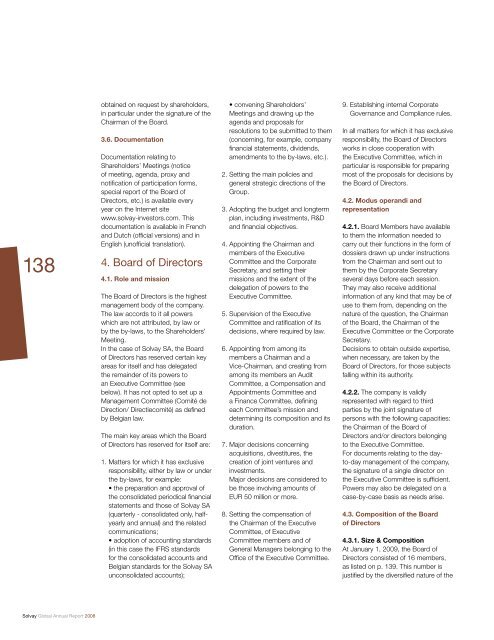

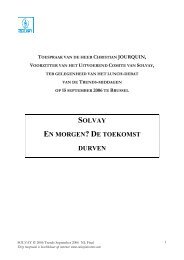
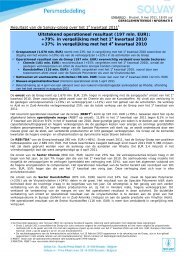

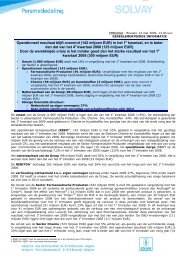
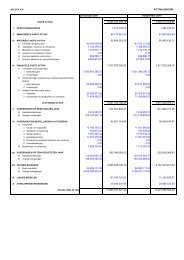


![PROC.1 [LETTRE] - Solvay](https://img.yumpu.com/16585746/1/184x260/proc1-lettre-solvay.jpg?quality=85)
